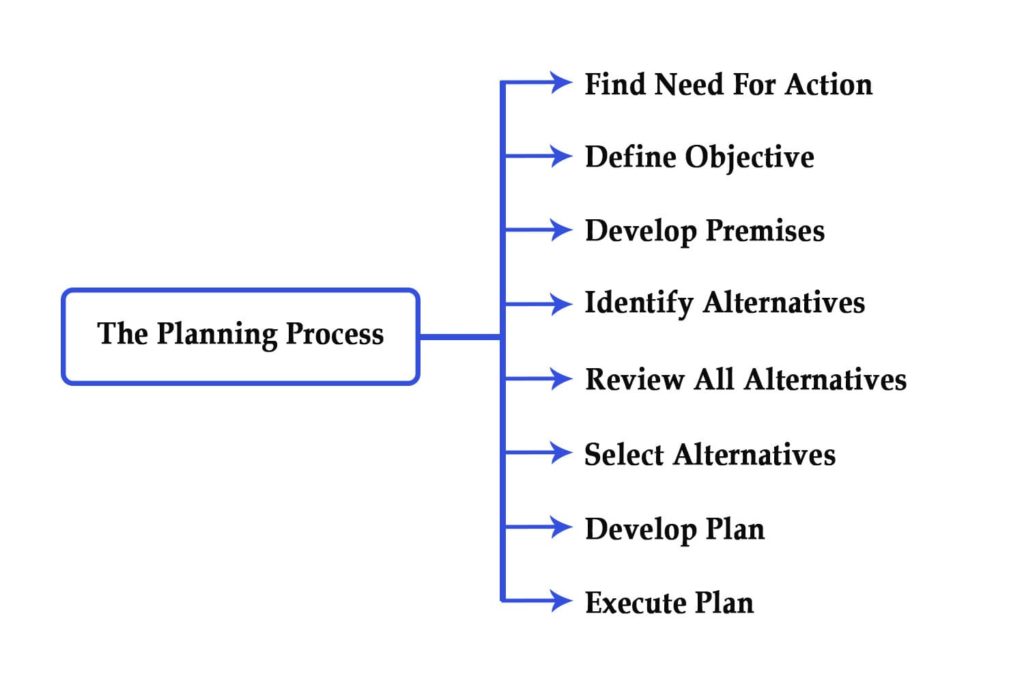Planning is thinking about how to achieve a goal. It can be formal or informal. Informal planning involves discussions and decisions, while formal planning is organized and written. Planning is a key management function. It determines when, how, and who will work to achieve objectives. It is a time-consuming process and is the first step in any business venture or operation.
The level of detail in planning depends on the objective. A plan helps an organization achieve its goal by clearly outlining its steps. It provides a roadmap for success and ensures everyone knows their role.
The Planning Characteristics

Planning has seven characteristics:
- Management Function: Planning is a management function that provides the foundation for an organization’s operation. It assigns tasks, distributes staff, and guides departments effectively. It ensures that resources are used efficiently and aligns activities with the organization’s objectives.
- Goal-Oriented: Planning focuses on achieving organizational goals by outlining steps to meet objectives. Every plan has specific goals, ensuring all efforts are directed toward measurable outcomes.
- Pervasive: Plans are present at all levels. Every department has a plan that aligns with the organization’s overall goals. It ensures that all units work cohesively, contributing to the organization’s larger purpose.
- Continuous Process: Planning is ongoing. Once objectives are achieved, new plans are created, and existing ones are updated as needed. It adapts to changing circumstances, ensuring the organization stays relevant and proactive.
- Intellectual Process: Planning requires effort, expertise, and knowledge. It involves critical thinking and informed decision-making. This process draws on experience and analysis to devise strategies that maximize efficiency and effectiveness.
- Futuristic: Planning focuses on the future. It includes forecasting to prepare for potential challenges. By anticipating risks and opportunities, planning helps organizations stay prepared and seize upcoming possibilities.
- Decision-Making: Planning involves choosing the best actions to achieve goals from several alternatives. It requires analyzing options, weighing risks, and making informed choices to ensure successful outcomes.
8 Steps to the Planning Processes

Planning is essential for an organization to set goals, manage resources, and achieve desired outcomes. It involves eight steps:
Step 1. Find the Need for Action
Organizations must identify business opportunities or challenges before they can create a plan. This step involves recognizing gaps, analyzing current situations, and using tools like SWOT analysis to determine areas of action.
Step 2. Define Objectives
This step sets the foundation for planning. Depending on organizational goals, objectives can be long-term or short-term. Clear objectives guide the planning process and ensure efforts are focused on specific, measurable outcomes.
Step 3. Develop Premises
Planning involves forecasting future conditions, which requires making assumptions known as premises. These premises can be internal (policies, organizational culture, resources) or external (market conditions, political factors, technological advancements). Accurate premises ensure realistic planning.
Step 4. Identify Alternatives
There are multiple ways to achieve every objective. This step involves brainstorming and identifying all possible courses of action that can lead to the desired outcome.
Step 5. Review All Alternatives
After identifying alternatives, each option is carefully evaluated based on feasibility, cost, risk, and potential outcomes. This ensures that the organization can make an informed choice.
Step 6. Select an Alternative
This is the decision-making stage where the best course of action is chosen. The selected alternative should align with the organization’s goals and provide the most effective results.
Step 7. Develop the Plan
Once an alternative is selected, detailed plans are created. These include setting timelines, allocating resources, defining roles, and outlining specific actions to achieve objectives.
Step 8. Execute the Plan
This is the implementation phase, where planned activities are carried out. The organization ensures that resources, personnel, and processes are in place to execute the plan effectively. Regular monitoring ensures the plan stays on track toward achieving the goals.
The Limitations of Planning
The following are the key limitations of planning:
- Rigidity: Once plans are approved, they can create rigidity in execution, making it difficult to adapt to changes. This inflexibility can hinder the organization’s ability to respond to unforeseen circumstances.
- Ineffectiveness in Dynamic Environments: Planning may not be effective in rapidly changing or agile environments. Frequent shifts in priorities, market conditions, or technology can render plans outdated or irrelevant.
- Limited Creativity: Overemphasis on structured planning can stifle creativity and innovation. It may lead organizations to play it overly safe, missing out on unconventional or bold opportunities.
- Time and Cost-Intensive: Planning requires significant time, effort, and resources, which can delay decision-making. This cost may outweigh the benefits, especially for smaller or fast-moving projects.
- Dependence on Assumptions: Planning often relies on assumptions about future conditions. Too many or inaccurate assumptions can result in flawed plans, leading to inefficiencies or failure in execution.
Summary
Planning is vital for any organization’s survival and growth. It provides a structured approach to setting targets and achieving goals, ensuring resources are used effectively. Planning helps organizations stay focused and prepared for future challenges by defining objectives and outlining steps to reach them. It helps departments and staff to coordinate their efforts, fostering teamwork and collective success.
While planning has limitations, such as rigidity and reliance on assumptions, its benefits outweigh the drawbacks. A well-thought-out plan acts as a roadmap, guiding organizations toward their objectives and ensuring long-term stability and progress in a dynamic business environment.
